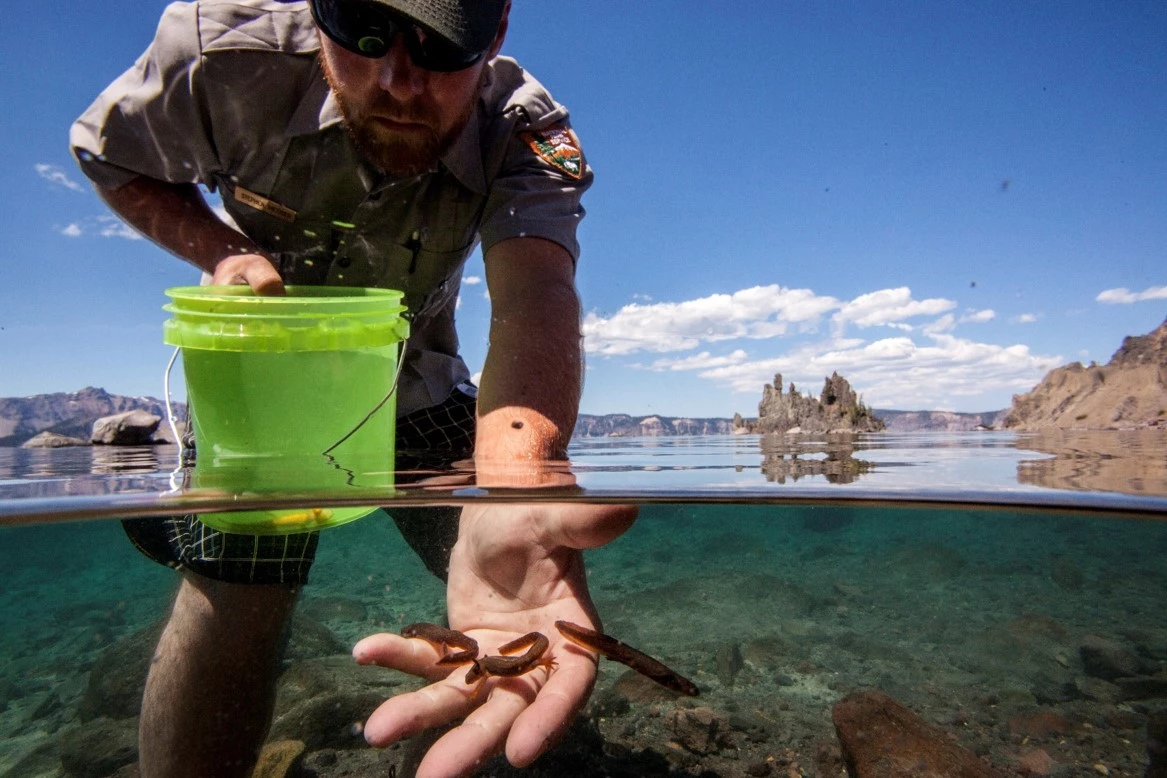Last updated: March 10, 2021
Article
A Century Later: Scientists Study the Impact of Crayfish Introduction at Crater Lake National Park


NPS
In 1915, signal crayfish (Pacifasticus leniusculus) were introduced into pristine Crater Lake as a food source for non-native fish that had already been introduced. A century later, these aggressive crustaceans have spread to 95% of the 35 km (22 mi) of shoreline, causing major impacts to the native invertebrate species in the lake . A salamander subspecies known as the Mazama newt (Taricha granulosa mazamae), which is found only within the caldera of Crater Lake, depends on the same aquatic invertebrates as food that are heavily impacted by the crayfish. Because of this, the Mazama newt is poised to disappear as crayfish continue to spread.
Unfortunately, controlling crayfish with current technologies is impractical given the sheer size of Crater Lake, the rocky habitat, and the extreme range of depth over which crayfish live (as deep as 250 meters/820 feet!). As a test, Park scientists attempted to control crayfish on an isolated island (Phantom Ship) within Crater Lake. But after three years of intense trapping, crayfish numbers did not decline. Instead, they actually increased tenfold! Like most crayfish taxa, the signal crayfish is nearly impossible to remove once established.

NPS
Although stopping crayfish spread is unlikely, park scientists have continued to study its impact so that others may learn from this century-old mistake. Crater Lake is an ideal location for such studies because the lake is protected entirely within a National Park. The ecological effects of crayfish are easier to decipher in the protected area, where they are not complicated by other human-induced changes common in other lakes (e.g. harvest, water withdrawals, nutrient inputs, hydroelectric fluctuations, forestry, fisheries management, boating, etc.). Below are a few lessons learned from studies in Crater Lake.
Impact of Warming Climate
Annual surveys of crayfish density by park scientists suggest that long-term changes in weather affect both abundance and movements of crayfish. Average winter temperatures at Crater Lake have increased 1.6 °C since 1965, and the length of the summer period (defined as warm water floating on the lake surface) is ~33 days longer. Warmer water temperature in winter allows more crayfish to survive, and longer summers give crayfish more time to spread spatially around the lake when surface water is warm. These results suggest that warming climate at northern latitudes and higher elevations may allow signal crayfish to invade and survive in lake systems that were previously too cold.

NPS
Impact on Benthic Insects
Since 2008, park SCUBA divers have collected insect samples at areas with and without crayfish. These studies show that the presence of crayfish reduces biomass of bottom dwelling insects by more than 90%. Some insect taxa are virtually eliminated when crayfish invade, especially snails and caddisflies. Along the rocky bottom of Crater Lake, Mazama Newts rely on these same insects for food.
Impact on Algae
The massive reduction in insect biomass leads to an increase in algal concentration growing on the rocky shoreline due to fewer insect grazers. Likewise, the crayfish invaders appear to increase the overall productivity of the nearshore habitat, the consequences of which are not well understood. It is still unknown whether these ecological changes within the nearshore area affect the water clarity that makes Crater Lake so blue.
Because crayfish are easy to introduce into lakes and streams, they have become a major threat to aquatic habitats around the world. Spread of crayfish has been driven by various factors, including their use for aquaculture, educational specimens, bait for fishing, and even the pet trade. The crayfish species introduced into Crater Lake is a particularly problematic invader in areas of Europe, Japan, and North America; especially California and Nevada. Lessons learned by studying crayfish invasion at Crater Lake National Park may help managers in other areas reduce the spread of this destructive crustacean.
